Jörmungandr
nadesłał Jarosław Ornicz – tłumaczenie Czesław Białczyński
The other day I came across this pendant on one of the auction sites with the description: „Medieval Period – Viking Pendant Depicting Coiled Sea Serpent – Jörmungandr”. Lot closed. 145$…
Jörmungandr
Pewnego dnia natknąłem się na ten wisiorek na jednym z serwisów aukcyjnych z opisem: „Średniowieczny okres – wisiorek wikingów przedstawiający zwiniętego węża morskiego – Jörmungandr”. Już Zamknięte. 145 $ …

In Norse mythology, Jörmungandr is a giant serpent whom Odin tossed into the great ocean that encircles Midgard. The serpent is so large that it is able to surround the earth and grasp its own tail, receiving the name „World Serpent”. It’s arch-enemy is the thunder-god Thor…
W mitologii nordyckiej Jörmungandr jest gigantycznym wężem, którego Odyn rzucił do wielkiego oceanu otaczającego Midgard. Wąż jest tak duży, że jest w stanie otoczyć Ziemię i chwycić własny ogon, więc otrzymuje miano „Wąż Świata”. Jego arcy-wrogiem jest bóg piorunów Thor …

The German Myth–Thor. Illustration from With the World’s People by John Clark Ridpath (Clark E Ridpath, 1912).
The stories about Thor’s encounters with this serpent are very interesting. They are full of symbols whose meaning, by the time the stories were recorded, was almost completely forgotten…Uncovering the meaning of these symbols will show us the true identity of Jörmungandr…
Historie o spotkaniach Thora z tym wężem są bardzo interesujące. Są pełne symboli, których znaczenie w momencie zapisania opowieści zostało prawie całkowicie zapomniane … Odkrycie znaczenia tych symboli pokaże nam prawdziwą tożsamość Jörmungandra …
Before I analyse the only two preserved Norse stories about the encounters between Jörmungandr and Thor, I will first just quickly remind you all of the main thing Thor (as the thunder god) has to do in Indoeuropean mythology: he has to kill the dragon (Serpent)…
Zanim przeanalizuję tylko dwie zachowane nordyckie historie o spotkaniach między Jörmungandrem i Thorem, najpierw szybko przypomnę wam co właściwie Thor (jako bóg piorunów) ma do zrobienia w opowieściach mitologii indoeuropejskiej: musi zabić smoka ( Węża)…
The identity of this Dragon (Serpent) can be deduced from, for instance, the Slavic myth about Perun, Thunder god, killing Veles, Great Serpent, who stole Perun’s cattle (clouds). Perun kills Veles, releases his cattle (clouds), and rains return…
Tożsamość tego smoka (węża) można wywnioskować na przykład ze słowiańskiego mitu o Perunie, bogu gromu, zabijającym Welesa, wielkiego węża, który ukradł bydło Peruna (chmury). Perun zabija Welesa, uwalnia swoje bydło (chmury) i deszcze wracają …
Snake is in Slavic mythology directly linked with the sun. It is the symbol of sun’s heat. The symbol of summer. The snakes are in the underworld during the winter and are in our world during the spring, summer autumn, when sun dominates the Sun-Earth system…
Wąż jest w słowiańskiej mitologii bezpośrednio związany ze słońcem. To symbol ciepła słonecznego. Symbol lata. Węże są w zaświatach zimą i są w naszym świecie wiosną, latem, jesienią, kiedy słońce dominuje w Układzie Słońce-Ziemia …

In the spring, sun’s heat is a positive force which creates life. But as summer progresses, the heat gets stronger and stronger. And by the end of the summer, sun’s heat becomes a negative force which destroys life. And so the snake grows into the Great Snake, The Dragon…
Wiosną ciepło słoneczne jest pozytywną siłą, która tworzy życie. Ale wraz z upływem lata upał staje się coraz silniejszy. A pod koniec lata ciepło słoneczne staje się negatywną siłą, która niszczy życie. I tak wąż rośnie w Wielkiego Węża, Smoka …
The dragon that has to be killed, or his fiery breath will turn everything into cinder. Ta-Dah!!! Enters The Thunder god of your choice, battle ensues…and the dragon dies…The drought ends, the rains return, the world is saved (again)…
Smoka, którego należy zabić, lub jego ognisty oddech zamieni wszystko w popiół. Tadah!!! – wychodzi od Boga Grzmotów , obojętnie jak tam go sobie nazwiesz, i bitwa się kończy … smok umiera … Susza się kończy, deszcze powracają, świat jest uratowany (ponownie)
In Slavic mythology, Thunder god Perun kills Great Snake Veles on Perun’s day, 2nd of August, the day that marks the end of Summer, and beginning of Autumn. This day falls in the middle of Leo zodiac sign, when sun is the hottest…I talked about this in my post „Thundering sun god„…
W słowiańskiej mitologii bóg piorunów Perun zabija Wielkiego Węża Welesa w dniu Peruna, 2 sierpnia, w dniu oznaczającym koniec lata i początek jesieni. Ten dzień przypada w środku znaku zodiaku Lwa, kiedy słońce jest najgorętsze … Mówiłem o tym w moim poście „Grzmot boga słońca” …
So, Great Serpent, Dragon (Draught) dies in Leo Slightly smiling face Or to say it another way, Lion kills Serpent. This Romanesque object depicts Lion killing Snake under the head of Helios. Perun’s day is in Serbia also the day of St Elijah, Christianised Helios…I talked about it in my post „Lion killing snake„…
Tak więc Wielki Wąż, Smok (Dragon/Draught – Przeciąg) umiera w Lwie – lekko, z uśmiechem na twarzy – lub inaczej mówiąc, Lew zabija Węża. Ten romański obiekt przedstawia Lwa zabijającego Węża pod głową Heliosa. Dzień Peruna jest w Serbii również dniem św. Eliasza, chrystianizowanego Heliosa … Mówiłem o tym w moim poście „Lew zabijający smoka/węża” …
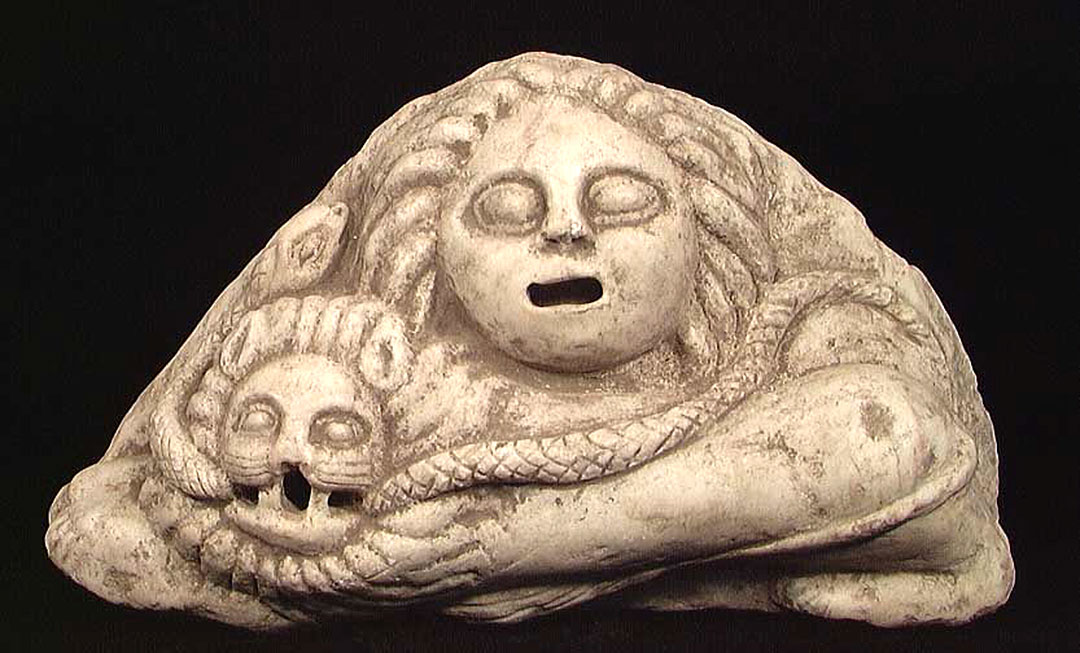
Ok, back to Thor and Jörmungandr. This is one of only two preserved stories about the encounters between the Thunder god and the Great Serpent…You’ll love it…
Ok, wracając do Thora i Jörmungandra. Oto jedna z dwóch zachowanych opowieści o spotkaniach boga piorunów z Wielkim Wężem … Pokochasz to …

The part „the serpent disguised by magic in the form of a magic colossal cat” would make no sense at all, if we didn’t know that in Slavic mythology, the Thunder God fights and kills the Great Serpent in the middle of Leo…
Fragment „wąż przebrany dzięki magii w postać magicznego kolosalnego kota” nie miałaby żadnego sensu, gdybyśmy nie wiedzieli, że w słowiańskiej mitologii Bóg Grzmotów walczy i zabija Wielkiego Węża w środku Lwa. ..
Now all of a sudden it all makes perfect sense…Including the fact that Thor can’t lift the Great Serpent disguised as a Great Cat. One other story, from Egypt, can also be decoded using the same symbol dictionary: The story of Apep, Great Chaos Serpent…I talked about this in detail in my post „Apep„…
Teraz nagle wszystko ma doskonały sens … W tym fakt, że Thor nie może podnieść Wielkiego Węża przemienionego w Wielkiego Kota. Inną historię z Egiptu można również odkodować przy użyciu tego samego słownika symboli: Historia Apepa, Wielkiego Węża Chaosu … Mówiłem o tym szczegółowo w moim poście „Apep” …
Guess what. Apep is killed by Ra (Sun) in a form of a Cat (Leo)…When the Great Serpent is killed, inundation of the Nile is at it’s highest level, nature is saved, hence the tree behind the snake…
Zgadnij o co chodzi. Apep zostaje zabity przez Ra (Słońce) w postaci Kota (Leo) … czyli Wielki Wąż zostaje zabity wtedy, gdy wylew Nilu jest na najwyższym poziomie, natura zostaje uratowana, stąd drzewo za wężem …
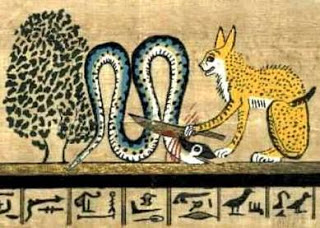
Of course this whole thing doesn’t make much sense in far north, where there is little chance of sun causing draughts…
Oczywiście cała ta sprawa nie ma większego sensu na dalekiej północy, gdzie istnieje niewielkie prawdopodobieństwo, że słońce spowoduje „przeciągi” …
Jörmungandr and Thor meet again when Thor goes fishing with the giant Hymir. Hymir is a very interesting giant indeed. He is the father of the god Týr, whom Romans identified as Aries, the god of War…
Jörmungandr i Thor spotykają się ponownie, gdy Thor idzie na ryby z gigantycznym Hymirem. Hymir jest naprawdę bardzo interesującym gigantem. Jest ojcem boga Tyra, którego Rzymianie zidentyfikowali jako Barana, boga wojny …
Now in Slavic mythology, god Jarilo, is the Young Sun God, who was in Greek Mythology personified by Apollo, who replaced Helios, the old Titan (Giant) Sun God…
W mitologii słowiańskiej bóg Jaryło jest Bogiem Młodego Słońca, który był w mitologii greckiej personifikowany przez Apolla, który zastąpił Heliosa, starego boga Słońca, Tytana (Giganta) …
The root of the name Jarilo is „jar” which can mean both „green, young” and „raging heat, raging anger”. Jarilo is symbol of male (and Sun) energy, which can be both creative and distructive…It is suspicious how close Jarilo is to Ares, the god of rage (jara)…
Korzeniem nazwy Jaryło jest rdzeń „jar”, co może oznaczać zarówno „zielony, młody”, jak i „szalejący upał, szalejący gniew”. Jaryło jest symbolem męskiej (i słonecznej) energii, która może być zarówno twórcza, jak i odwrotnie destrukcyjna … Podejrzane jest, jak blisko Jaryle jest do Aresa, boga wściekłości (jara) …
So is Giant Hymir, the father of Týr (Ares, Jarilo) actually Titan Helios? After all Perun kills The Great Seapent on the day of Helios, the hottest day in the northern hemisphere…And here in this story Thor kills Jörmungandr while fishing with Hymir (father of Ares)…
Czy więc Giant Hymir, ojciec Týra (Ares, Jarilo), faktycznie jest Tytanem Heliosem? Po tym, jak Perun zabija Wielkiego Węża w dniu Heliosa, najgorętszego dnia na półkuli północnej … I tutaj także, w tej historii Thor zabija Jörmungandra podczas łowienia z Hymirem (ojcem Aresa) …

This story is great. The part: „Hymir refuses to provide Thor with bait, Thor strikes the head off Hymir’s largest ox to use as his bait” makes no sense unless we know that Summer which is ruled by The Great Serpent, starts in Taurus, Bull…
Ta historia jest świetna. Fragment: „Hymir odmawia dostarczenia Thorowi przynęty, Thor uderza głowę w największego wołu Hymira, aby użyć go jako swojej przynęty” nie ma sensu, chyba że wiemy, że lato rządzone przez Wielkiego Węża rozpoczyna się w Taurusie, Byku …
In Slavic mythology, Perun kills the Great Serpent at the end of summer. At the end of the season whose symbol is The bull…So Bull also dies on Perun’s day…I talked about this in my post „Symbols of the seasons„…
W mitologii słowiańskiej Perun zabija Wielkiego Węża pod koniec lata. Pod koniec sezonu, którego symbolem jest byk … Więc byk również umiera w dniu Peruna … Mówiłem o tym w moim poście „Symbole pór roku” …

That there is a direct link between bull and dragon can be seen from some legends preserved in the Balkans, in which young girls were sacrificed to the Giant Bull rather than to the Dragon…I talked about this in my post „Water bull„…
O tym, że istnieje bezpośredni związek między bykiem i smokiem, można się przekonać dzięki niektórym legendom zachowanym na Bałkanach, w których młode dziewczyny zostały poświęcone gigantycznemu bykowi, a nie smokowi … Mówiłem o tym w moim poście „Water bull” …
So Thor kills the bull to kill the Dragon…This is the Altuna Runestone showing Thor fishing for three headed dragon using a bull head…With his hammer on the ready to strike the final blow…
Więc Thor zabija byka, aby zabić Smoka … poniżej jest Kamień Runiczny Altuna, pokazujący, że Thor łowi trzygłowego smoka za pomocą głowy byka … Z młotem gotowym do ostatecznego uderzenia …
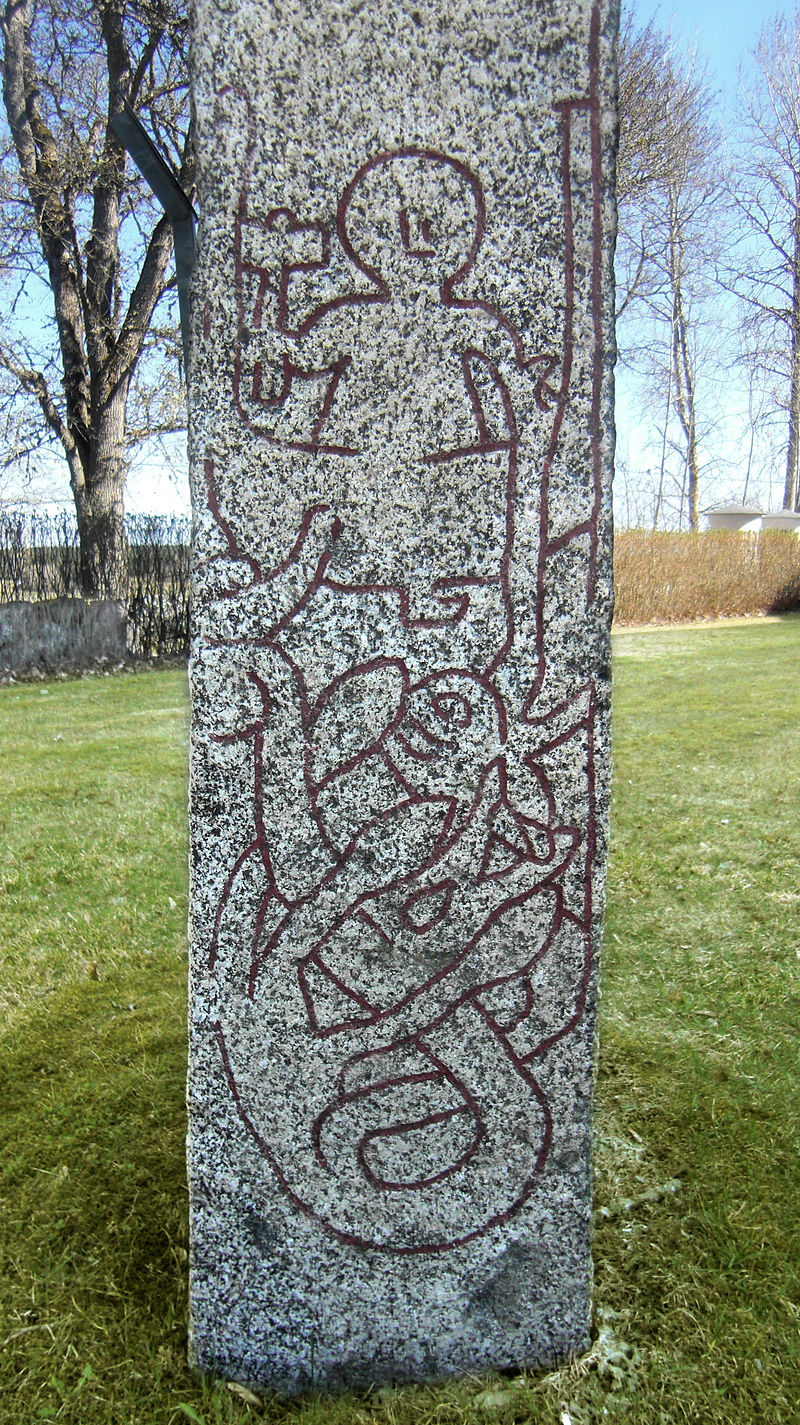
What is interesting is that in the Balkans, the day of Perun, the day of Helios, is the day when people organise Bull fights. I talked about this in my post „Alidjun„…
Co ciekawe, na Bałkanach dzień Peruna, dzień Heliosa, to dzień, w którym ludzie organizują walki byków. Mówiłem o tym w moim poście „Alidjun” …
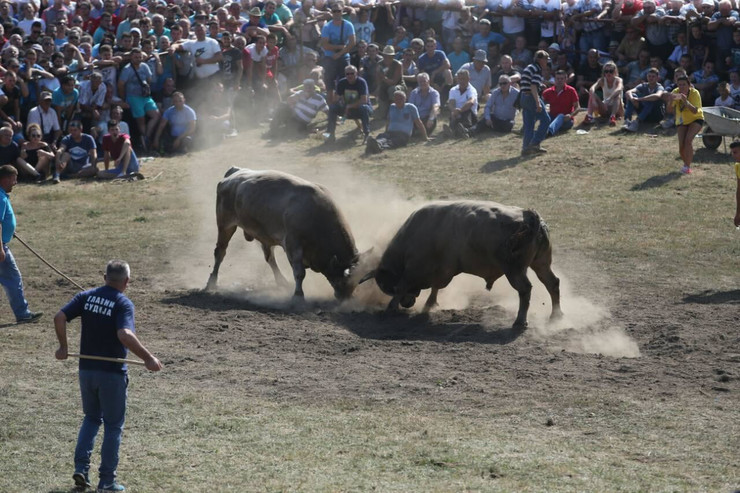
This is also the day when bulls are ceremonially slaughtered, roasted and eaten…Historical sources tell us that Slavs sacrificed bulls to Perun…So these bull fights were originally probably a ritual in which the best bull was chosen to be sacrificed to Perun…
Jest to również dzień, w którym byki są ceremonialnie ubijane, pieczone i zjadane … Źródła historyczne mówią nam, że Słowianie poświęcili byki Perunowi … Więc te walki byków były pierwotnie prawdopodobnie rytuałem, w którym wybrano najlepszego byka, którego ofiarowano Perunowi ...
I talked about ritual slaughtering of Bulls in Slavic culture, and the meaning of this ritual, in my post „Bull of Grom Div„…
Mówiłem o rytualnym uboju byków w słowiańskiej kulturze i znaczeniu tego rytuału w moim poście „Bull of Grom Div” …
But it wasn’t just Slavs who sacrificed bulls, symbol of summer which starts in Taurus, at the end of summer…The Old Gaels (The Irish) did it too. I talked about this in my post „Bull of Crom Dubh„…
Ale nie tylko Słowianie składali ofiary z byków, symbol lata rozpoczynającego się w Byku pod koniec lata … Zrobili to również Old Gaels (Irlandczycy). Mówiłem o tym w moim poście „Bull of Crom Dubh” …
So what are we to make of all this? Well, well done Thor, you are truly Indoeuropean Thunder god now. You killed your Great Serpent, Dragon…But why is it that this Norse legend can be explained through Slavic folk tradition, but not through Norse folk tradition? Or can it be?
Co więc mamy z tym wszystkim zrobić? Dobra robota Thor, teraz jesteś naprawdę bogiem Indoeuropejskiego Gromu. Zabiłeś swojego Wielkiego Węża, Smoka … Ale dlaczego tę nordycką legendę można wytłumaczyć słowiańską tradycją ludową, a nie nordycką tradycją ludową? Czy może tak być?
Also, as I already said, the story makes no sense in the far north. In the far north the Thunder god has no need to kill the heat of the summer. The opposite is the case…In the far north you want sun to be hot and the summer to last as long as possible…
Ponadto, jak już powiedziałem, historia nie ma sensu na dalekiej północy. Na dalekiej północy bóg Grzmotów nie musi zabijać upału lata. Jest wręcz przeciwnie … Na dalekiej północy chcesz, aby słońce było gorące, a lato trwało tak długo, jak to możliwe …
There is one more thing that can be decoded once we know what does the cat represent. Why is Freya riding around in chariots pulled by cats…She is just another representation of Virgo, the feminine, yin, earth influence which becomes ever stronger from the middle of Leo…
Jest jeszcze jedna rzecz, którą można odkodować, gdy wiemy, co reprezentuje kot. Dlaczego Freya jeździ na rydwanach ciągniętych przez koty … Jest to kolejna reprezentacja Panny, kobiecego, yinowego wpływu ziemi, który staje się coraz silniejszy od środka Lwa …

I talked about this ubiquitous Lion Lady in my post „Assumption of Mary„…
One other thing. Why is The Great Serpent Jörmungandr biting its tail? Enters Ouroboros. This symbol of the serpent biting its tail was first seen in Egypt. There it is linked to deity Mehen, who in other funerary texts protects Ra in his underworld journey…
O tej wszechobecnej Lwiej Pani mówiłem w swoim poście „Wniebowzięcie Maryi” …
Jeszcze jedna rzecz. Dlaczego Wielki Wąż Jörmungandr gryzie własny ogon? Tworzy Ouroborosa. Ten symbol węża gryzącego własny ogon po raz pierwszy pojawił się w Egipcie. Jest to powiązane z bóstwem Mehenem, który w innych tekstach grobowych chroni Ra w jego podróży do podziemia …
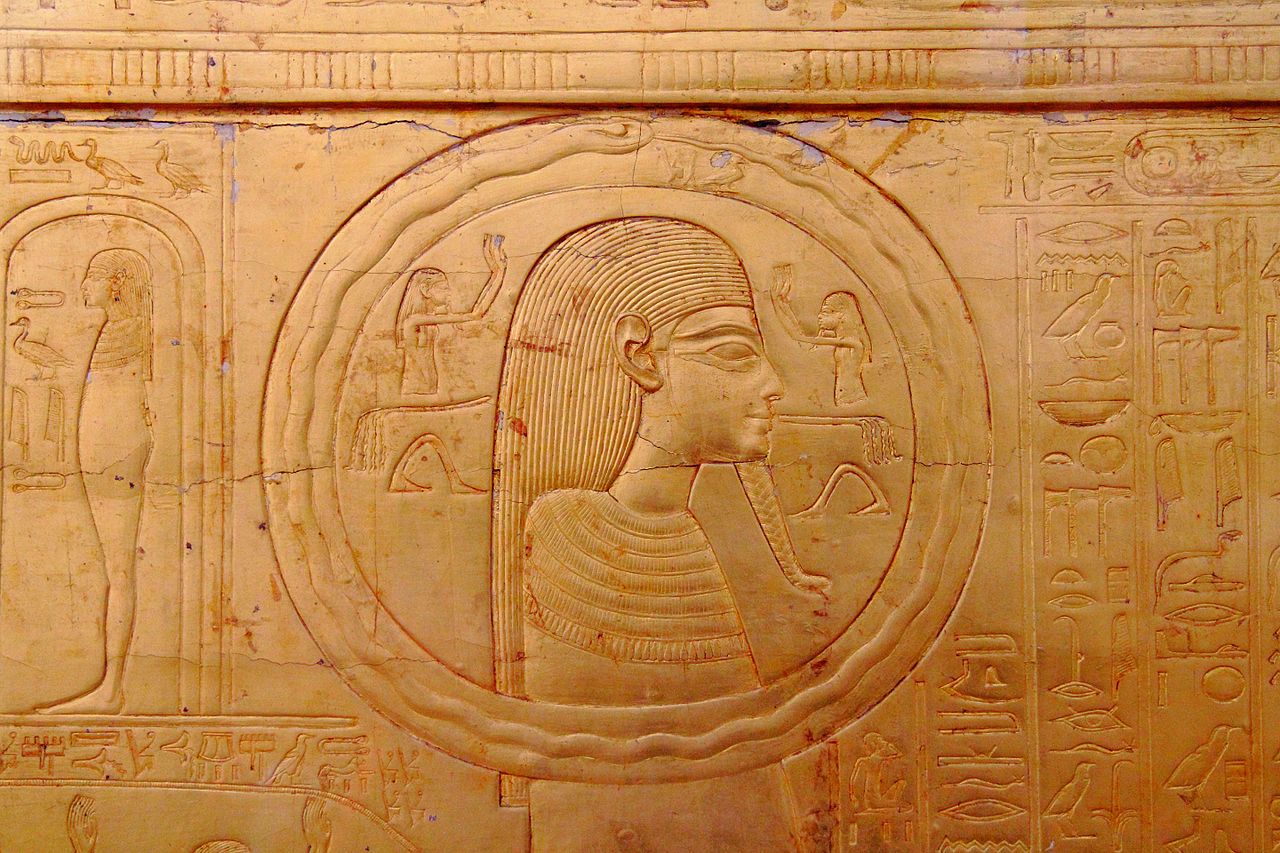
Ra spends every night in cold watery underworld. In order to emerge bright and shining in the morning, Ra’s fire, his heat, needs to be preserved. By coiled snake… Symbol of sun’s heat in Slavic mythology…
Ra’s heat also needs to be preserved during the winter. According to the 4th-century AD Latin commentator Servius who was aware of the Egyptian use of the Ouroboros symbol, the image of a snake biting its tail represented the cyclical nature of the year…Solar wheel…
Ra spędza każdą noc w zimnym wodnym podziemiu. Aby wyjść rano jasno i lśnić, ogień Ra, jego ciepło, muszą zostać zachowane. Przez zwiniętego węża … Symbol słonecznego ciepła w słowiańskiej mitologii …
Ciepło Ra również musi zostać zachowane podczas zimy. Według łacińskiego komentatora z IV wieku naszej ery Serviusa, który był świadomy egipskiego użycia symbolu Ouroborosa, wizerunek węża gryzącego ogon przedstawiał cykliczną naturę roku … Koło słoneczne …
That Ouroboros did represent the solar year, the ever turning (changing) life creating solar wheel, can be seen from Gnostic Pistis Sophia (c. 400 AD), which describes the ouroboros, the soul of the world, as a twelve-part dragon, surrounding the world with its tail in its mouth
To, że Ouroboros reprezentował rok słoneczny, wiecznie obracające się (zmieniające się) koło słoneczne tworzące życie, można zobaczyć w Gnostic Pistis Sophia (ok. 400 rne), który opisuje ducha naszego świata, jako dwunastoczęściowego smoka otaczającego świat z ogonem we własnym pysku.
In my post „Yin and Yang„, I talked about this ever changing, life producing interplay between the Earth and the Sun…
W moim poście „Yin i Yang” mówiłem o tej ciągle zmieniającej się, życiowej interakcji między Ziemią a Słońcem …
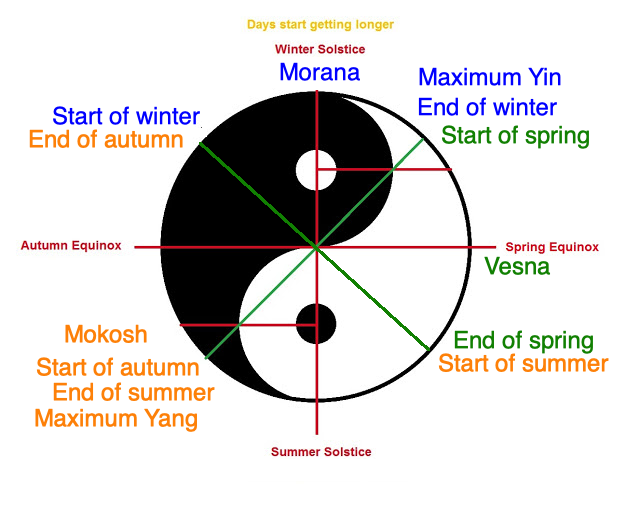
One thing that most people don’t know, is that the Yin-Yang symbol is spinning and ever changing. The Great serpent, the Sun, The Yang, is constantly oscillating between its minimum (in the middle of maximum Yin) to it’s maximum (where we find minimum Yin in the middle of it)…
Jedną z rzeczy, o których większość ludzi nie wie, jest to, że symbol Yin-Yang wiruje i ciągle się zmienia. Wielki Wąż, Słońce, Yang, nieustannie oscyluje między swoim minimum (w środku maksymalnego Yin) a maksymalnym (gdzie znajdujemy minimalne Yin w środku) …
This is what „Serpent biting it’s tail means”. Dragon, The Great Serpent doesn’t get killed by Thor or Perun or any other Thunder god. It kills (eats) itself. Spring-Summer-Autumn-Winter-Spring…The ever spinning Ouroboros, the solar wheel…
To właśnie oznacza „gryzienie się węża we własny ogon”. Dragon, The Great Serpent nie zostaje zabity przez Thora, Peruna ani żadnego innego boga gromu. On sam się zabija (zjada). Wiosna-lato-jesień-zima-wiosna … Zawsze wirujący Ouroboros, koło słoneczne …
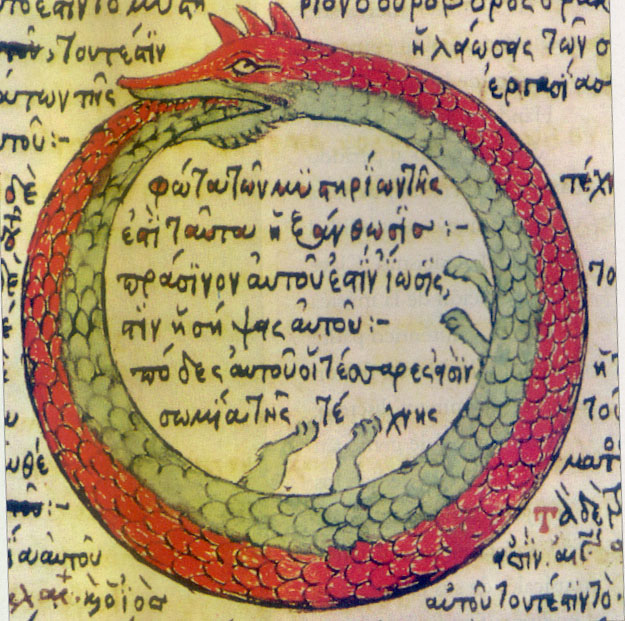
And this is why the end of the world will come when Jörmungandr spits its tail…Because that means that the Earth-Sun system has gone out of balance. The heat will either increase so much that the world will burn, or will decrease so much that the world will freeze…
I love Jörmungandr…
I właśnie dlatego nadejdzie koniec świata, kiedy Jörmungandr wypluje ogon … Ponieważ to oznaczać będzie, że układ Ziemia-Słońce stracił równowagę. Upał albo wzrośnie tak bardzo, że świat spłonie, albo temperatura spadnie tak bardzo, że świat zamarznie …
Wielbię Jörmungandra …
